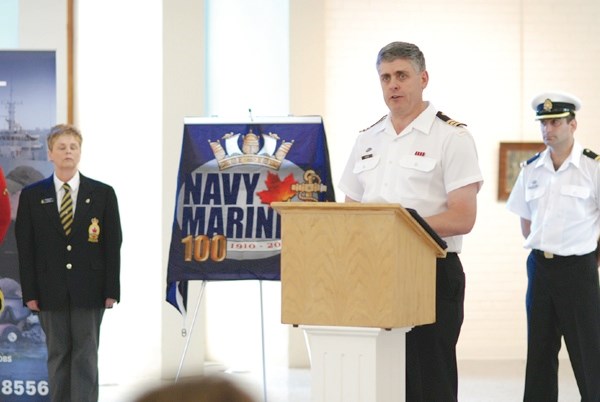There is pride in Moira Gautron's voice when she says her son is in the Canadian Navy. She also has a son who is a major in the air force.
"I'm really proud of the fact that they're both involved in the Canadian Forces," she said.
July 27, Gautron attended a ceremony held at the Chapel Gallery, in which her son, Lt. (N) Shane Gautron, took part.
A pictorial history of the HMCS Poundmaker was presented to the City of North Battleford as part of the centennial celebrations of the Canadian Navy. Over 300 communities, provinces and First Nations have had ships named after them since the navy was established in 1910.
Cmdr. Randy Hanson said, "These ships proudly represented their namesakes in times of war and peace, through the chilling waters of the Arctic, the fury of the North Atlantic, off the coast of Korea, in the Persian Gulf and today, in places like the Indian Ocean and off the shores of Haiti."
Hanson detailed some of HMCS Poundmaker's history during the Second World War, saying, "Poundmaker and her sister ships were guarding freedom's lifeline, and without their efforts and sacrifice, victory in Europe would not have been possible."
HMCS Poundmaker was one of two ships named to honour this region, the other being HMCS Battleford.
Gautron said she thinks the presentations, being held across Canada in ships' namesake communities, are important to teach people about the history of the soldiers who fought for Canada.
"We take our freedom for granted," said Gautron.
During the presentation, Hanson said many people, living far from Canada's ocean frontiers, are not aware of the navy's importance in protecting Canada's trading routes, providing assistance in emergencies and patrolling Canada's offshore resources, nor are they aware of the province's participation in the Canadian Navy.
"Despite our distance from the sea, Saskatchewan has a proud navy tradition," said Hanson.
During the Second World War, approximately 6,500 people joined the Navy through HMCS Unicorn in Saskatoon and HMCS Queen in Regina. Today, there are approximately 11,000 people in the Canadian Navy, with about 4,000 of those being reservists.
Gautron said she's heard it said people from the prairies make good sailors, speculating it may have something to do with the vast expanse of land, or the harsh conditions faced by early settlers.
"They were brave and resourceful," she said of the prairie settlers.
Mayor Ian Hamilton said he didn't realize the sheer number of people from Saskatchewan who enlisted in the navy during the Second World War.
"It just goes to show that we are significant and we do play an important part," said Hamilton.
For more information on this and other navy presentations, visit www.navy.forces.gc.ca.
SIDEBAR
HMCS Poundmaker facts
HMCS Poundmaker (K675) was a river class frigate built by Canadian Vickers Ltd. in Montreal.
The ship was launched in April of 1944, and commissioned into the Royal Canadian Navy Sept. 17 of the same year.
HMCS Poundmaker had a crew of 141 people and could travel at a speed of 19 knots.
The ship was well armed, having two 102mm guns, one 12-pound gun, eight 20mm guns, a Hedgehog mortar and depth charges.
Poundmaker joined Escort Group C-8, based in St. John's, Nfld., in December 1944.
For most of the war, HMCS Poundmaker served as a mid-ocean escort, protecting convoys on the Atlantic, between Newfoundland and Londonderry, Ireland.
HMCS Poundmaker left Londonderry for the last time May 11, 1945.
The ship was sold to the Peruvian navy in 1947, and decommissioned in 1968.




